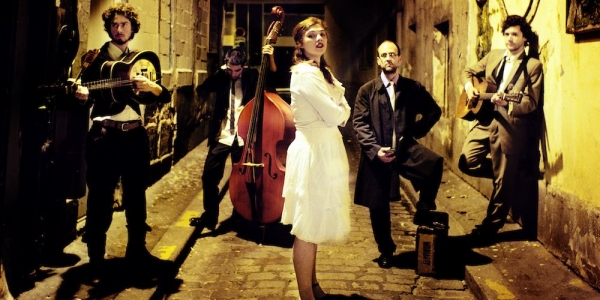Moriarty’s 2007 debut LP, Gee Whiz, But This Is A Lonesome Town, a decidedly bluesy concoction with touches of jazz, folk and cabaret, differs somewhat from their most recent release, 2011’s The Missing Room, a more stripped-back and acoustic affair. I asked Gillette about the difference in approach, and what their sound represents.
“I think with [The Missing Room], it was really written on the road during gigs, so that’s what the album’s all about,” Gillette reveals. “It sort of has that live energy going on.” When I ask him about what he thinks the missing room is he is philosophical. “The Missing Room; it’s sort of a sponge word, where you can really put whatever you want into it. Some in the band see it as a space between things; that little space you need to make things in harmony. Some other people in the band see it as a kind of hotel room, that sort of feeling of being on tour, cause we did a huge tour on [Gee Whiz…]; so you can put whatever you want into it!”
But even though Moriarty were busy touring, they never, ever let the road get the best of them – refusing to allow the various cities and towns they visited to become nothing more than a blur, they instead connect with their audiences and in doing so, enable a sort of mystique to envelope them. If only more bands were as approachable as this.
“We’re not the kind of band that just leaves the venue and goes back to the tour bus, disappearing into the night and swallowing the miles,” Gillette quietly insists. “We really do take an interest in staying in the places where we play and we try as much as possible to get out as fast as we can and meet the audience and talk to the people, and if we have any interesting encounters, we set out for all-night-long talking and bars and re-inventing our world!”
But what about the songs themselves? Such a disparate and manifold mixture of ingredients have gone into the work – how on earth do they come together, and what’s the writing process like for Moriarty? “It’s pretty diverse,” he admits. “We are, after all, a band with no leader, so there’s not one person who leads the thing and takes it in its direction. Which is good in some ways, but difficult in others – so a song isn’t finished until each one of us is happy with it and what it’s saying.
“For example, we have 150 songs that are just waiting, but not everybody is happy with them, so they’re just kind of slowly getting the sunshine and rain that they need!”
So technically they’re quite literally in the missing room? “Exactly!” laughs Gillette.“It all comes down to the direction [a song] takes,” he continues. “If a song’s going in one direction, there’s always somebody in the band who will totally demolish it and [the process] will start all over regularly.
“There’s a song called Cottonflower on Gee Whiz…, and it’s a song about this soldier dying on a battlefield in the first World War. Rosemary [Standley, vocalist] wrote the lyrics with Stephan [Zimmerli, bassist] and me, and we did the whole thing with a country-ish style. And then the drummer came in with a completely marshal rhythm on it, and then the bass player did a kind of New Wave bass line, which was completely surprising to the others and they thought it ruined the song. So yeah – that’s how we work! We all have little worlds of passion.”
But, I say to him, it all seems to work – just listening to their music seems to me to be evidence that their relationship is built on trust and friendship and respect. He heartily agrees. “We’ve all known each other for 15 years, and we just know how the other minds in the band work! There’s a lot of invisible music going on. And what’s really great is that we’ve been through so many things that I don’t think we can ever break up. We’re the kind of band that I’m sure will still be playing together when we’re 85 years old. We’re the kind of band where we know what we want and we know that we want to stay together!”
BY THOMAS BAILEY

